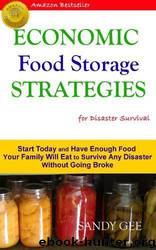Economic Food Storage Strategies for Disaster Survival: Start Today and Have Enough Food Your Family Will Eat to Survive Any Disaster Without Going Broke by Sandy Gee

Author:Sandy Gee
Language: eng
Format: mobi, epub
Publisher: Howson Books
Published: 2013-06-02T06:00:00+00:00
Dehydrating
If you don’t want to add excess salt to your foods, you worry about the carcinogenic qualities of nitrates or the possibility of the meat not drying sufficiently and containing botulism, you could skip the salting process and go right to dehydration.
Dehydration also offers a space saving alternative to canning, although if you store a lot of dehydrated foods, you’ll also need to store extra water, or have access to a reliable source.
Preparing food for dehydration
You can dehydrate most foods so long as they don’t have a high fat content. Fat in dehydrated foods will still go rancid and spoil.
If you want to dry fruit and vegetables, choose food in optimum condition, ensuring they are ripe, unbruised and with no signs of insect infestation.
Cut meat, fruit and vegetables into strips, slices, cubes, or whatever shape you want to serve the end result in. Keep pieces of uniform size, so they all dry at the same time, and you won’t have to worry about larger piece still having moisture where bacteria can grow in the center.
Wash or peel fruit and vegetables and trim all fat off meat. For apples or other foods that will brown with exposure to the air, steaming, sulfuring or coating in ascorbic acid or lemon juice will prevent this. Blanching vegetables will deactivate the enzymes that make them mature and help stop them toughening up so much during dehydration.
Strange as it may sound, brining or marinating meat prior to dehydration is a good way to enhance the flavor of the end result. You’ll also need to cook the meat in the marinade and leave it to drain and cool before drying.
Dehydrating equipment
You can dehydrate food in a conventional oven on its lowest heat setting with the door cracked open to encourage air circulation in 8 to 12 hours. To use this method, arrange the food on pizza trays with perforations on the oven shelves, and turn the trays once or twice during drying to account for any cool spots in the oven.
You could also purchase a commercial dehydrator. These range from the plastic Nesco Food Dehydrator, which looks like a small kitchen steamer and will set you back around $40, to the Excalibur Stainless Steel Dehydrators, which run into the hundreds of dollars. Whether or not you decide to invest in one of these kitchen toys will depend on how much and how often you want to dehydrate and, of course, your budget.
If you want the cheapest method of dehydration, and one you can use without power, provided you live in a warm enough climate, you can use good old solar power to dehydrate your food. Although you could air dry in the open air, constructing a solar dryer from black and clear polythene and bamboo poles is a simple matter that offers protection from insects, pests and dust, while reducing required drying times, so if you take to dehydrating and you have a little space, setting one of these up could be ideal.
Download
Economic Food Storage Strategies for Disaster Survival: Start Today and Have Enough Food Your Family Will Eat to Survive Any Disaster Without Going Broke by Sandy Gee.epub
This site does not store any files on its server. We only index and link to content provided by other sites. Please contact the content providers to delete copyright contents if any and email us, we'll remove relevant links or contents immediately.
The Culinary Herbal by Susan Belsinger(2061)
My Pantry by Alice Waters(2040)
Food and Water in an Emergency by Food & Water In An Emergency(1991)
Asian Pickles: China by Karen Solomon(1855)
Food Storage for Self-Sufficiency and Survival by Angela Paskett(1671)
Project Smoke by Steven Raichlen(1667)
Smoke & Spice by Cheryl Alters Jamison(1586)
Pure Charcuterie: The Craft & Poetry of Curing Meat at Home by Meredith Leigh(1364)
Asimov's Science Fiction 020111 by Dell Magazines(1266)
The Jam and Marmalade Bible by Jan Hedh(1262)
Fermented Vegetables by Kirsten K. Shockey(1255)
Economic Food Storage Strategies for Disaster Survival: Start Today and Have Enough Food Your Family Will Eat to Survive Any Disaster Without Going Broke by Sandy Gee(1220)
The Ideal Pantry: Your Comprehensive Guide to Food Remedies and Preservation Techniques by Ben Night(1200)
Asian Pickles by Karen Solomon(1189)
The Healthy Meal Prep Cookbook: Easy and Wholesome Meals to Cook, Prep, Grab, and Go by Amidor RD CDN Toby(1179)
Canning for a New Generation by Liana Krissoff(1174)
Not Just Jam: The Fat Pig Farm book of preserves, pickles and sauces by Evans Matthew(1144)
Jams, Preserves and Chutneys by Marguerite Patten(1077)
The Complete Guide to Drying Foods at Home: Everything You Need to Know About Preparing, Storing, and Consuming Dried Foods by Paajanen Terri(1076)
